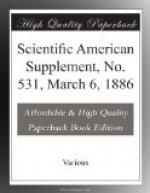Annatto is the coloring matter derived from the seeds of an evergreen plant, Bixa Orellana, which grows in the East and West Indian Islands and South America, in the latter of which it is principally prepared. Two kinds are imported, Spanish annatto, made in Brazil, and flag or French, made mostly in Cayenne. These differ considerably in characters and properties, the latter having a disagreeable putrescent odor, while the Spanish is rather agreeable when fresh and good. It is, however, inferior to the flag as a coloring or dyeing agent. The seeds from which the substance is obtained are red on the outside, and two methods are followed in order to obtain it. One is to rub or wash off the coloring matter with water, allow it to subside, and to expose it to spontaneous evaporation till it acquires a pasty consistence. The other is to bruise the seeds, mix them with water, and allow fermentation to set in, during which the coloring matter collects at the bottom, from which it is subsequently removed and brought to the proper consistence by spontaneous evaporation. These particulars, culled from Dr. Redwood’s remarks, may suffice to show its source and the methods for obtaining it.
Dr. John gives the following as the composition of the pulp surrounding the seeds: Coloring resinous matter, 28; vegetable gluten, 26.5; ligneous fiber, 20; coloring, 20; extractive matter, 4; and a trace of spicy and acid matter.
It must be understood, however, that commercial annatto, having undergone processes necessary to fit it for its various uses, as well as to preserve it, differs considerably from this; and though it may not be true, as some hint, that manufacturing in this industry is simply a term synonymous with adulterating, yet results will afterward be given tending to show that there are articles in the market which have little real claim to the title. I tried, but failed, to procure a sample of raw material on which to work, with a view to learn something of its characters and properties in this state, and thus be able to contrast it with the manufactured or commercial article. The best thing to do in the circumstances, I thought, was to operate on the highest priced sample at disposal, and this was done in all the different ways that suggested themselves. The extraction of the resin by means of alcohol—the usual way, I believe—was a more troublesome operation than it appeared to be, as the following experiment will show: One hundred grains of No. 8 were taken, dried thoroughly, reduced to fine powder, and introduced into a flask containing 4 ounces of alcohol in the form of methylated spirit, boiled for an hour—the flask during the operation being attached to an inverted condenser—filtered off, and the residue treated with a smaller amount of the spirit and boiled for ten minutes. This was repeated with diminishing quantities until in all 14 ounces had been used before the alcoholic solution ceased to turn blue on the addition to it of strong




